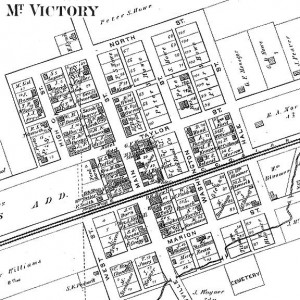MV’s Traditional Neighborhood Design
Mount Victory is a prime example of Traditional Neighborhood Design (or Development)
Residents and merchants often overhear visitors saying “this is such a quaint town!” But what makes Mount Victory “quaint” and inviting is by no means an accident. The village was platted in an 1800’s style that has come to be defined by architects as Traditional Neighborhood Design. The principles for this style of town planning were simple and straightforward – hundreds of towns in Ohio were laid out in a similar way.
Typical TND (Traditional Neighborhood Design/Development) characteristics include grid patten streets with parallel alleys – garages to the side or rear of the property, sidewalks, smaller, more human scale lot sizes, similar proportioned houses that include a variety of architectural styles and common facade or front porch set backs. You’ll notice on most streets in town how the front porches are all about the same distance from the sidewalk – the distance to comfortably carry on a conversation with a passing neighbor. (notice homes built in the 70’s and later are often set further back into the lot)
Most folks don’t give much thought to these physical characteristics – they just know there is a distinct difference between an older town and a newer suburb. But it is this difference that makes Mt. Victory a quaint historic village – these characteristics equal a human scale that charming. (imagine if Disney’s Main Street looked like a suburb instead of a historic Main Street… and you start to get the idea).
Another characteristic of TND is the inclusion of public ‘nodes’ – these are public places where people gather to meet, play, shop, etc. These are usually established as a 5 to 10 minute walk from one another. Here in MV there are 4 main ‘nodes’ – the elementary school in the west section of town, Main Street’s business block in the center, the village park to the northeast and the town cemetary to the south
Residential properties were laid out in a rectangular pattern. Each rectangle a separate property division. Most were and still are 1 chain x 3 chains. A ‘chain’ is an early measurement used in land descriptions that is equal to 66 feet. Most all properties – even those on Main Street – are 66 ft. wide by 198 ft. deep. Plots were designed back to back with a service alley between them. Then a standard street in the front that was 1 chain (66 ft.) wide.
Streets were planted with hardwood trees in the ‘tree lawns’ (the grassy area between the sidewalk and the edge of the street) This planting used to be done for the practical purpose of creating afternoon shade before the invention of AC – today it is still done for that reason as well as asthetics – it serves as a great cooling device for houses plus a protection against winter winds. It also aids in water retention and reducing storm water runoff. (Mount Victory has a hard working tree commission dedicated to the health of our existing trees and replacement of older specimans)
What’s Old is New Again
The irony is that many property developers have stopped building standard suburbs and started using the TND formula instead. The advantages include dramatic reductions in the consumption of open space; better long term health and sustainability for neighborhoods; dissipation of conflict between developers and residents; increased mobility choice for residents (especially children, seniors and those with physical limitations); improved air and water quality; a heightened sense of community and civic pride; the list goes on.
Read More…
Sustainable Cities »
Smart Growth »

